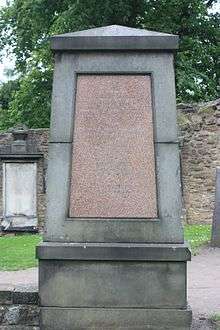Robert Cadell
Robert Cadell (16 December 1788 – 20 January 1849) was a bookseller and publisher closely associated with Sir Walter Scott.


Life
He was born at Cockenzie, East Lothian, Scotland, the fifth son of John Cadell, a Laird of Cockenzie, and Marie Buchan, his wife.
Cadell's career began as a clerk at Archibald Constable & Co., Sir Walter Scott's publisher, where he later (1809) became a partner in the business. The connection to Constable was also personal: Cadell married his daughter Elizabeth in October 1817. She died less than nine months later. Cadell married again (to Anne Fletcher Mylne) in 1821, adding to the friction which had developed between Constable and Cadell since the death of Elizabeth. The two men were very different characters: Cadell was cautious and lived plainly, while Constable's lifestyle was lavish and he took risks in business.
When Constable's London agents Hurst Robinson went bankrupt and Archibald Constable & Co. itself fell into receivership in January 1826 through the effects of Scott's own bankruptcy, the partnership between Cadell and Constable dissolved. Scott chose to remain with Cadell, respecting Cadell's prudence in business affairs.
Scott and Cadell purchased the copyright to Scott's novels and produced a new edition of the Waverley novels including new material penned by Scott. The work to create this ‘author's edition’ commenced in 1827 and was highly successful, in part perhaps because of the illustrations executed for it by J. M. W. Turner.
Cadell took care of Scott in the writer's last years, profiting handsomely from arrangements made with Scott's family after his death such that they were absolved from debt in return for Cadell's exclusive right to republish Scott's novels and biographical material. On Scott's death, Cadell paid £30,000 for Scott's share of the copyright on Scott's work, thereafter owning it outright.[1] Cadell's wealth enabled him to acquire considerable land and personal property, including Ratho House, in Midlothian.
He died at the family home in Cockenzie on 20 January 1860 and is buried in Greyfriars Kirkyard in central Edinburgh.[2] The grave stands at the head of one of the western lines in the western extension.
Family
He first married Elizabeth Constable, daughter of his employer Archibald Constable. She died in 1818.
He was then married to Anne Fletcher Mylne (1796–1867).
They had a son John in 1826 who only lived for 6 weeks. Their daughter Emily (1821–1832) also died young.
References
- Monuments and monumental inscriptions in Scotland: The Grampian Society, 1871
- Monuments and monumental inscriptions in Scotland: The Grampian Society, 1871
- Oxford Dictionary of National Biography
- 'Litera scripta manet': George Huntly Gordon and the Abbotsford Library Catalogue (Oxford Journals)